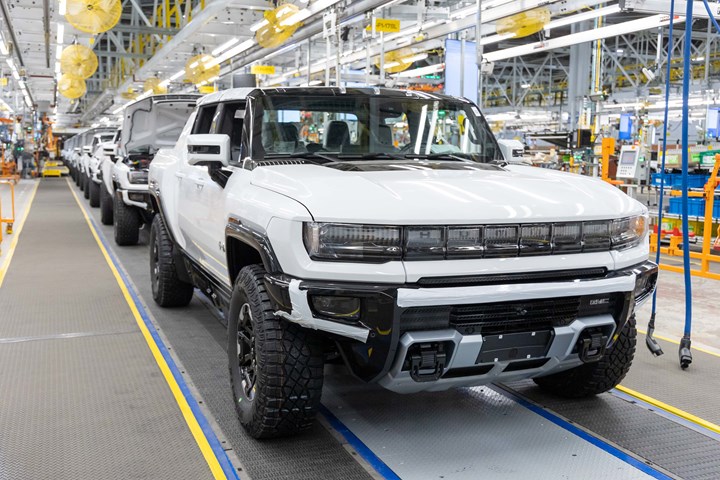PPG Reveals the Most Popular Auto Colors
Let’s admit it: there isn’t a whole lot of change when people show up at their dealerships to buy a new set of wheels.

As this 2022 GMC HUMMER EV rolls off the line at the GM Factory ZERO plant it (and if you look closely, you’ll see the same holds for the following vehicles) is a perennially favorite color in North America.
Photo Credit: Jeffrey Sauger for General MotorsAlthough some might think that nowadays people are more expressive — which could manifest itself in the choice of colors selected for their vehicles — according to the “PPG 2021 Global Automotive Color Popularity Report” vehicle owners in North America mainly opt for colors that are not exactly nondescript, but certainly short of colorful.
That is:
- Gray/Silver: 34%
- White: 24%
- Black: 18%
That’s 76%.
The only other color that is in double digits is blue, at 12%.
What’s interesting to note is that back in 2015 things were not substantially different:
- Gray/Silver: 32%
- White: 23%
- Black: 19%
Or, 74% of all vehicles were painted those colors in North America in 2015.
One difference is that the only other color in double digits was red, at 10%. Blue was back at 8%. Red peaked in 2018 at 11%. In the 2021 report it is back at 7.5%. (However, when it comes to body styles, it isn’t entirely surprising that red is at 12% for sporty vehicles—although blue bests it at 16%.)
The two most popular vehicle types in the U.S. are light trucks and SUVs. The achromatic dominance of the gray/silver, white and black in the overall numbers can be attributed to their popularity for those vehicles.
Looked at another way, for light trucks:
- Blue: 6%
- Green: 5%
- Brown: 1%
- Orange: 0.5%
- Red: 9.5%
And the gray/silver, white and black account for all the rest.
What could be surprising is that SUV buyers are less color-intensive than even the buyers of pickups:
- Blue: 10%
- Green: 2.5%
- Brown: 0.5%
- Orange: 0.5%
- Gold/Beige: 0.5%
- Red: 7.5%
Putting a brighter spin on the dominance of the gray, etc. Misty Yeomans, PPG color styling manager, automotive OEM, Americas, notes that there are an increasing number of two-tone finishes, an approach that was popular in the 1950s and 1960s, although back then paint shops required plenty of masking as multiple runs of vehicles through the spray booths to attain the colors. Now there are precision application methods deployed.
What happens when you mix black and white. . . ?
Related Content
-
Masking Solutions Provider CFS Dramatically Expands Capabilities and Capacity
Custom Fabrication & Supplies (CFS) completed a new plant expansion packing 10 times the capacity into twice the space. It dramatically enhances the supplier’s custom capabilities to provide extremely precise and cost-effective masking solutions.
-
Concrete Reinforced Bars Built to Last
Not all corrosion-resistant materials for infrastructure are created equally. Epoxy-coated steel rebar has advantages that other materials used to prevent corrosion do not.
-
Mix of Automation and Skilled Employees Generates Quality
This Pennsylvania plating company’s general manager shares insights about being recognized as a Top Shop for several consecutive years as well as his thoughts about automation, customer service, hiring skilled workers, the challenges of installing a new line and more.

.jpg;width=70;height=70;mode=crop)












.jpg;maxWidth=300;quality=90)

